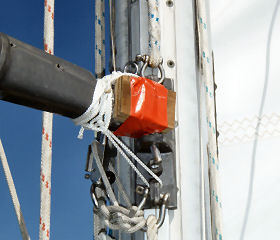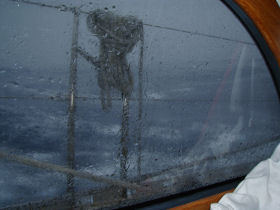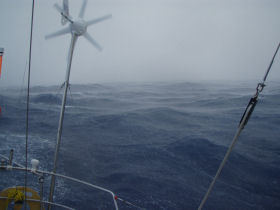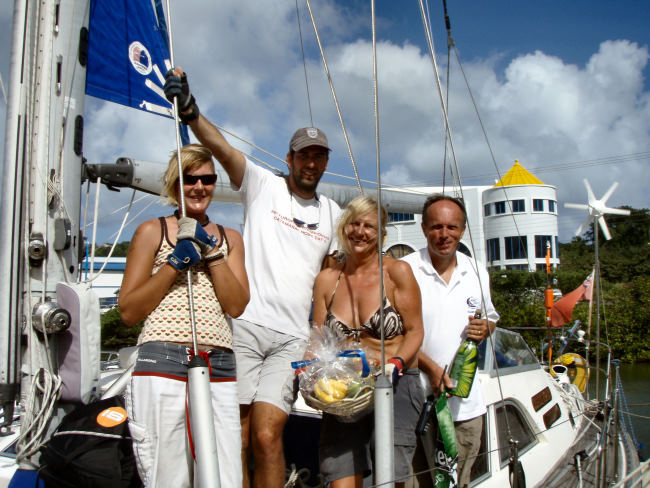Yet another Atlantic crossing
Panoramic View of Gran Canaria
Yet another Atlantic Crossing.
Well it wasn't, this was my 4th crossing, third in this direction. I confidently predicted that "I'd practically worn out that bit of Sea". This it turned out was arrogance. This was not just another Atlantic crossing. Initially things preceded along the expected lines. Fixing, shopping etc. Interspersed with some drinking. The Weather in Gran Canaria was more variable than I remembered. This should have been a warning. The last 2 nights before we left, the wind was howling from the North, it was cold actually cold. In the Canaries! We were in the bar in oliles. The weather didn't make preparations such as laundry any easier. The ARC weather guru promised us the wind would drop overnight and it would be sunny for the start.
Arc start line.
The start was much as I remembered from the previous ARC. Except breezier. Given the breeze most of us started cautiously. As well as the Breeze the swell was big too. We got away cleanly, the radio was thick with those who didn't, we saw one boat with a broken boom before we even started. Gaviotta of Cowes was towed into the southern end of the island with no rudder and a fouled prop. Pindar, a Volvo 60 was spotted 4 hours in beating north towards Las Palmas under headsail alone.
We carried on south, to stay out of the wind acceleration zone and then the wind shadow of the islands. During the night I had to avoid the same yacht twice, he inconsiderately didn't give way despite being on Port. Then at midnight gybed and crossed our path again. During the night a racy carbon boat called "Helen Mary Gee" was knocked down. That's carbon racy with a washing machine....
Island Kea II and her crew in the light winds of Gran Canaria.
Standard wisdom is: "Sail south until the butter melts and then turn right", well we decided to turn right early. We lost wind a little south of the Canaries, but not as bad as those who cut the corner. Our first few days were relatively slow as the strong northerly wore off. We had dolphins every evening for 5 days, with some whale blows spotted north of us on the 3rd day out. At this point the Navtex reported: "Risk of Locust plague arriving Canaries" Glad we missed that. The Current and wind at the Cararies both come from the North East. Sending us a little south. The current and wind both become more easterly as you get further across. The Wind and Current keep the Canaries relatively cool. Snow is not unknown at the top of the Island (1500M). The water temperature in the Caribbean is 5 degrees warmer. But it warms up pretty quick as you go across.
The lighter winds didn't give us spectacular progress and the Canarian current doesn't knock the miles off the GPS the way the Equatorial current does. a few days in we started deploying the Parasailor (a weird spinnaker with a hole in it an a kite in the hole) or the Cruising chute during the day, giving us some extra oomph.
Spinnaker Pole Gooseneck (modified)
We'd had our first problem with the autopilot, fortunately just a loosened bolt, a few days in but on the 10th day the actually ram went, this was a new part instilled at Gibraltar. To get at Island Kea's Autopilot, the cockpit locker has to be emptied, since this is a major store of bikes, gas bottles, diesel and marine junk it takes along time. One must then crawl into the locker, open a hatch and crawl under the aft cockpit. Whilst rolling in the trades. Fortunately we were able to replace the new ram with the old and carry on with an autopilot. I can't stress how important some type of automatic steering is, if you standing watch alone, you can't do anything with more than one hand or more than an arm length from the helm.
As well as autopilot troubles we had to repair the spinnaker pole, the universal joint kept loosing pins all the way across, I don't believe it was engineered with the constant working of an Atlantic passage in mind. Despite the trouble we got the fishing gear out, making a huge tangle. However the following day we caught a lovely dorado.
Dorado (nice with lemon and garlic)
Weather forecasts indicated a hole developing in the wind ahead we drove the boat south west for a few days as we approached the halfway point, in search of wind.
By this time we'd heard a fair few more troubles coming through on the Radio, Steve our skipper was on of the Group C net controllers. One of the race boats has a burn patient on board, who had to be evacuated. Then 4 days out into the Atlantic, Tulla another yacht and flute encountered a boat load of 48 illegal immigrants, that far out into the Atlantic they were in serious trouble having missed the Canaries by hundreds of miles. Flute's skipper told me they didn't even have a compass. Apparently 2 had already died before they encountered the yachts. We'd been warned about the problem, thousands try and make the journey from Africa to the EU by taking unsuitable boats from the African mainland to the Canaries. I have heard stories of the contrast of western tourists sunbathing on the southern beaches as the police carry body bags of the many immigrants who don't make it up the same beach. The boat encountered by the ARC yachts has fuel left to try and board them. 2 of them succeed in getting on board Tulla. Flute was following them as best they could in case Tulla's crew were thrown off. The 2 boarders were subdued with a flare gun and cable ties. but Flute and the others had an unpleasant night as they boat approached them in the dark. Eventually after some wrangling a fishing boat was diverted to pick up the survivors.
South of us a non ARC yacht was in trouble. They lost a chain plate and were about to loose the rig. Gigi, a swan 48 picked them up from a life raft. Unfortunately the yacht didn't sink. With the Equatorial Current and the wind behind it even under bare poles it was making 50 miles a day. Apparently the crew included a very good cook. Its very heard to see a darkened yacht in heavy seas with no moon. The possibility of the yacht being near us made for some nervous night watches, especially because in this case there's no one as never as you on the other boat keeping look out for you.
Spinnaker pole went again. Now its held together by, a boat hook, a block of wood, a jubilee clip some string and some gaffer tape. We crossed the halfway point with the pole back up, bubbly with lunch. This was what it was supposed to be like. Windy sunny and blasting towards St Lucia.
Storm Force 10
The following evening a black cloud started creeping up behind me at 2 in the morning. I conscientiously reefed. Not enough, not nearly enough. The true wind meter went to 43 knots (Severe Gale 9). I had to struggle to keep the boat on course, and shout for help to get sails in. This wasn't just a squall - a normal hazard of the Atlantic. It carried on and it rained and it rained and it rained. I finally got to get some kip at 4:30, we were still doing 5 knots under bare poles. The following day it rained and rained. Eventually at sunset a break in the clouds appeared a head. This was unfair as the wind was astern. The wind started to rise again, clearing 35 knots steady and then holding 40 knots or more. The gusts remained in the high 40's (storm 10). This is not what I was expect from the Atlantic. Or what the weather forecast said. A nearby boat e-mailed cowes and question the 20-25 knots 30 in thunder showers forecast. The reply was along the lines of are you sure its 40kn? Doesn't look like that from my forecasts? YES WE'RE SURE, we were doing 11 knots down a wave on bare poles!
During this period of inclement weather the autopilot fortunately behaved. As well as the rain we had massive seas, imagine 2 bungalows coming from 2 directions and occasionally arriving at once and you'll get the idea. Night was back as soot. The boat was like a sauna, wet oilies and closed hatches. The next day was at least sunny, though we had numerous squalls, often vicious as well. But at least with squalls you can just strip off to your boxers and have a shower till there gone rather than import water bellow in your oilies.
Squall (v wet)
The morning of the 13th day out from Gran Canaria began with a 40 knot squall, 40knots stings when it hits your bear back. After the squall the rain set in again. This was probably our roughest day, the previous days of bad weather kicking up the swell and the rain making roll up smoking nigh on impossible. Huddled in the damp sweaty cabin I made fresh bread which didn't help the temperature.
The 14th day dawned clear, we could see the line of bad weather behind us. Which worried us.It was still rough and not in the normal Atlantic rolling waves way either, but it was sunny, 20-25 kn of breeze. Wonderful after 3 days of 35 kns being a break.
"Spam" a non ARC boat ahead of us lost her rig and was taking on water. Her 3 crew are safe aboard another yacht and I believe she sank. I was later told that 4 non ARC yachts were lost on the crossing this year. As well as Spam, the Skipper of one yacht had an accident, he was evacuated to a cruise ship and taken to hospital in Barbados. He unfortunate died of his injuries.
Our troubles with the autopilot appeared again, this time in the form of a snapped bolt which we were able to replace. But only by switching spares between old an new rams. Our weather troubles were now over, "Georgia" our second autopilot working and we were now able to appreciate haw much more ocean was behind us than in front, sit back and enjoy a beer with out too much fear. St Lucia came up fast in those last few days, our ETA went from Friday to Thursday night, then we comfortably rounded Pigeon Island a lunchtime on the Thursday. Despite loosing the last remaining functional autopilot combo 24 hours out. We beat into the bay, gave the photographer a wave and crossed the line in 18 days, 108th in the cruising Division of 169 boats. . Rum punch, beer, more beer etc.
Arrival at Rodney bay Marina, St Lucia - in one piece.
This is largely a we-write of a blog post "At Sea" I made as I went long, many of the photos here are available larger in the ARC 2007 gallery
20° 0' N, 40° 0' W

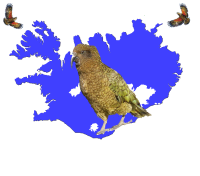

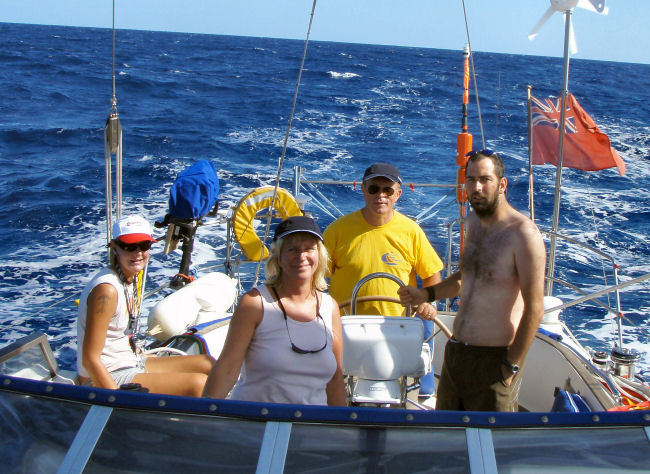
 Standard wisdom is: "Sail south until the butter melts and then turn right", well we decided to turn right early. We lost wind a little south of the Canaries, but not as bad as those who cut the corner. Our first few days were relatively slow as the strong northerly wore off. We had dolphins every evening for 5 days, with some whale blows spotted north of us on the 3rd day out. At this point the Navtex reported: "Risk of Locust plague arriving Canaries" Glad we missed that. The Current and wind at the Cararies both come from the North East. Sending us a little south. The current and wind both become more easterly as you get further across. The Wind and Current keep the Canaries relatively cool. Snow is not unknown at the top of the Island (1500M). The water temperature in the Caribbean is 5 degrees warmer. But it warms up pretty quick as you go across.
Standard wisdom is: "Sail south until the butter melts and then turn right", well we decided to turn right early. We lost wind a little south of the Canaries, but not as bad as those who cut the corner. Our first few days were relatively slow as the strong northerly wore off. We had dolphins every evening for 5 days, with some whale blows spotted north of us on the 3rd day out. At this point the Navtex reported: "Risk of Locust plague arriving Canaries" Glad we missed that. The Current and wind at the Cararies both come from the North East. Sending us a little south. The current and wind both become more easterly as you get further across. The Wind and Current keep the Canaries relatively cool. Snow is not unknown at the top of the Island (1500M). The water temperature in the Caribbean is 5 degrees warmer. But it warms up pretty quick as you go across. 